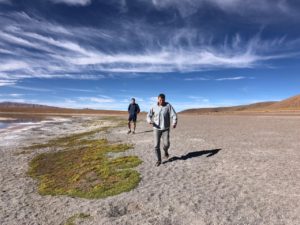Bolivia
I arrived in Bolivia and immediately went to Villamontes to get some things done. I needed to draw some cash and buy myself a Bolivian sim card. Exchanging money gets quite expensive here so all of it goes into the fuel costs at the boarder.
The banks are still super ‘sacred’ here. The ATM wasn’t working so I knocked on then office window. Apparently I knocked during their lunch break and security immediately approached me. I went to the next bank and whilst waiting, I pulled out my phone to look at photos. I was asked to switch it off or leave. When I asked why, security was already on their way to me and my immediate response was “bullshit” (this was not received well) I think they were glad when they finally got rid of me.


The first 100kms on the road were super with great driving conditions. After this came a dust road, but relatively straight towards the mountains.
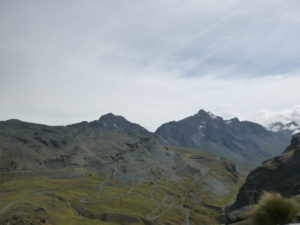
I decided to drive to the city Tarija but unfortunately only made it to Entre Rios, the dust road came with a maximum of 40km/hI found a German family in Entre Rios that own a small hotel that they started working on around 18 years ago, with minimal resources. Today they have a house, 2 Cabañas, a restaurant and a swimming pool. I spent a nice cool night there, even managed to give my mosquito attacked body a break. Insect spray hasn’t helped in the least, doesn’t even matter how many different types I’ve tried
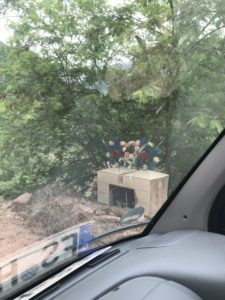

I drove on, on what was supposed to be a tarred road, but both navigation systems led me onto unpaved, dirt roads. I got myself some red bull, tiredness is something I cannot afford. There were little crosses along the road, identifying all the places where people have tragically died- something quite sad to see.
The worst parts would be controlled by ‘marshals’ with walky-talkies, who would then take turns to stop drivers.
Sometimes I had to play snow plow and use the underbody of the car to get the gravel back into the ruts, it hurt both me and the car…

The road from Entre Rios to Tarija was very dangerous. It had just rained and there was a heavy fog. There wasn’t much traffic though, most others were probably driving on the paved roads. I encountered more cows, goats, sheep, pigs and donkeys, than I did other cars. Therefore, the red-bull  stayed in the fridge, this environment produced enough adrenaline to keep me up for a while.
stayed in the fridge, this environment produced enough adrenaline to keep me up for a while.
The highest pass that I drove was at 4200 above sea level, it was pretty alright for me but I noticed that with Emmazwo, over 3000 meters you can’t do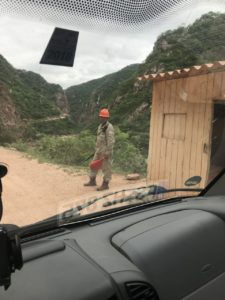
I arrived in Tupizas just as darkness rolled in, after very diverse pull overs along the way, which included a very intensive group of 4 guys, smelling quite intense as well (the air conditioning couldn’t get that smell away quick enough)
In Bolivia, you have to constantly sign papers and take every receipt, every meter of every road that you drive is written down in the toll papers with multiple stamps and notes. I went to a public bathroom and even got a receipt for the toilet paper they handed out!
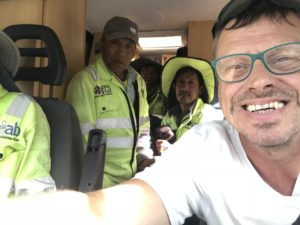
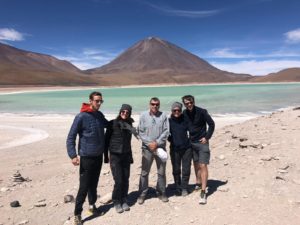
The car was incredibly dusty, so I went on a search for a car wash. A hand car wash costed around 5€. This let me inspect the underbody of the car, I was unhappy to discover that the cover of the alternator had been broken. I found a repair shop that replaced the fan belt, the replacing of it cost a super 8€, and I even got the cover of the alternator fixed. While it was being repaired, I decided to do a Jeep tour through Salar de Uyuni and the boarder lying national parks. I was lucky with the other. participants, 3 French guys and one from Bavaria. The driver and cook were also quite easy to understand.

Here, we drive through salt deserts and to experience warm waters, you can bath in volcano waters, at high altitudes.
We also went up to the highest spot above sea level, 5000m! I met a german guy who was travelling with his bike that he has been pushing along for days, due to the depth of the sand.

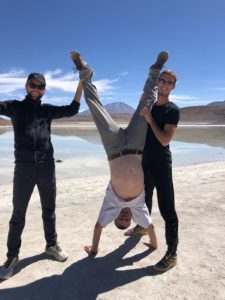
I was scared that I was suffering a bit from the aftermath of my previous embolism. I jogged 200 meters to the car at 5000 meters above sea level and I did’nt collapse, so I think I should be fine!
I finally know the difference between Lamas, Alpacas and Vicunjas.
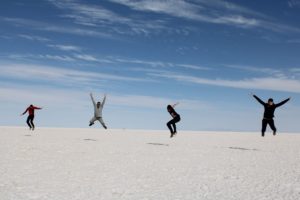
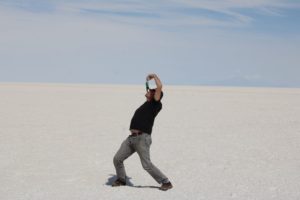
We took some crazy photos at Salar de Uyuni, the others are just as fantastically weird as I am. The landscapes of southern Bolivia are absolutely astounding; the mountain ranges, the lagoons and the salted deserts are indescribable. The people are a bit different, you need some patience but after a while they become better. I even stayed a night at a salt hostel, everything is made out of salt!
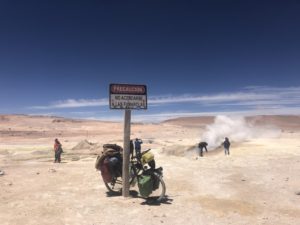

Rene, our driver, was the first to receive one of my three pairs of Würth sunglasses. Him and his wife (our cook) gave us the most wonderful tour.
I had the car repaired in Tupiza for 13€. Apparently the sounds are coming from the air-conditioning compressor, it will soon die on me.
On the way to Sucre, I was stopped by a very pretty lady and her mother- they were on their way to Potosi and there wasn’t a bus they could take. The first 100kms were rather quiet, the Boliviens are reserved.. For what its worth, white people firstly stole their gold, then their culture and then the treasures of their land. After a while we fell into conversation. Her mother is travelling to Potosi, where she will meet with her sister to take a 12 hour bus to Santa Cruz to visit family.
As we continued talking, I found out that the young lady also wanted to go with but couldn’t as she had bad back pain and stomach aches. A bit later, after we found trust in one another, the pains were described as pregnancy symptoms.
Her one eyed mother apparently speaks Spanish, just not with me. She speaks only ‘Quechua’ to her daughter. She has a very big family of 15 kids that are waiting for them in Santa Cruz.
Just before Potosi, there was a quick change of plan. After numerous phone calls to the sister that is currently waiting at the bus terminal, the young lady has no more pain. She has taken medication for it all and feels totally well, enough to travel with. She wanted to quickly go home to pack some things. While she was packing her things, her mother sat down on the street. Safe to say, her wide skirt shielded eyes of bystanders while she relieved herself…
It took forever for her to pack her ‘few things’, so when we arrived at the terminal, the bus was already gone. Another quick plan change, and off to the graveyard- the bus will drive past here. We got to the graveyard, the sister was standing on the street and the bus was gone. Plane change- off to the terminal, return the tickets and then we were on our way to Sucre.
The tickets couldn’t be returned so another Plan Change- chasing down that bus! Our disadvantage, 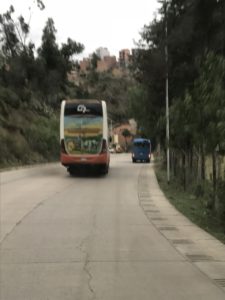 the bus had a 30 minute head start. So we picked up the sister and I put the pedal to the metal to catch the bus. The ladies informed me that they didn’t actually know where the bus station was, and did so 20 kilometers before arriving in Sucre. The internet search was aborted when the medication for nausea was suddenly ineffective, thank god a plastic bag was within reach. The full plastic bag was throw out the window before eagerly using up my wet wipes, which I lucky was able to stop from flying out as well. The earlier internet search for the bus station wasn’t successful which caused a big discussion in Quechua with petrol running low. What could I do? Around 20km diesel left, almost in Sucre with no sense of direction and suddenly there was an explosion of laughter: we had caught up to the bus!
the bus had a 30 minute head start. So we picked up the sister and I put the pedal to the metal to catch the bus. The ladies informed me that they didn’t actually know where the bus station was, and did so 20 kilometers before arriving in Sucre. The internet search was aborted when the medication for nausea was suddenly ineffective, thank god a plastic bag was within reach. The full plastic bag was throw out the window before eagerly using up my wet wipes, which I lucky was able to stop from flying out as well. The earlier internet search for the bus station wasn’t successful which caused a big discussion in Quechua with petrol running low. What could I do? Around 20km diesel left, almost in Sucre with no sense of direction and suddenly there was an explosion of laughter: we had caught up to the bus!
The bus station was on the other side of the city, so I quickly drew up a plan in my head. I’d fetch 5 litres of fuel with a taxi. To make matters worse, the siding door jumps open and the sisters didn’t understand the locking mechanism, so quickly pack everything safely and chase the bus with an open door. What are the odds, the bus stops directly opposite a petrol station!
There was barely time for goodbyes, the bus driver even thanked me. The petrol station was one fo the few in the city, very run down though. However, it serves its purpose of fuelling the car and serving coffee and refreshing drinks.
The petrol costs 9 Bolivian boliviano for tourists and 3,8 bolivianos
For locals. A tip from camping friends was to look for a petrol station without computers so that you can bargain. 6 bolivianos was the best I could get and taking pictures is definitely not allowed.


At the camping place I met Felicidas and Alfredo, he is a 70 year old professor at the university who was working with new electrical motors int he gazebo. Like with every house, campers also get renovated and updated. The mess in my bathroom is getting to me. I found a roof rack that allows me to have some storage on the roof of Emmazwo, everything that I do not use too often will go up there. The mounting of it was difficult because I had no ladder or cutters. I then moved onto the Light problem of another ‘customer’ who was shocked as to how many tools I have.
Most least evening in Sucre brought very bad weather. It was hailing, very heavily and with quite huge rocks. I was afraid that there was going to be damage to my solar panels. Quite an amount of water was getting pushed through cracks in the car, but the damage was nothing compared to that of neighbouring campers. 
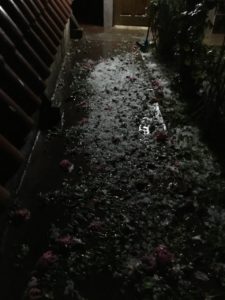
I need to add to my list of losses. I lost my soft shell jacket, I think I might have left it in the coffeehouse. The owner told me that things like that will not hang there for long, thank god I didn’t leave anything in the pockets- I’m not missing anything.
Further I drove to Cochabamba which lies at about the same sea level as Sucre. Emmazwo and I did however have to drive up a 3700 meter pass to get there, at this point it’s not funny anymore.
I again picked up some hitchhikers, a mother and her child were on their way to Auquile to get to the hospital. There was a language barrier between us so little understanding, but eventually we got it. She was a mother of 9 children, the youngest being 10 years old with a very bad cough. I dropped them right in front of the hospital and I think they were quite glad when I refused the money they offered.
Sadly I learned that my air-conditioning has said a farewell, I’ll have to get the car properly checked in Chile seeing as the summer is still ahead of me.
All I did in Chochabamba was cook some food and then straight to bed- the camping site was too far outside of the city.

The next morning, I made my way to La Paz, both my navigation systems pranked me and led me to a river. This caused some bad language on my end because this involved a 30km long dirt road. The iPhone took this personally and just switched itself off. The other GPS was an effort to sort out but eventually I found some bridges. Already had some stress because locals had gotten stuck already, Emmazwo is much bigger and heavier so this was a bit daunting but everything went fine.

Drove through dust over the mountains, reaching about 4300m. Up there, there was a petrol station for priority where the diesel costs 5 Bolivianos for everyone. I saved about 20€!
I arrived at Colibri Camp in a town just south of La Paz just as the sun was setting. Completely exhausted, I quickly ate and went straight to bed.
I was reader a travels guide on La Paz, and it’s true that the houses here are not plastered so they are considered ‘unfinished’- thus less taxes need to be 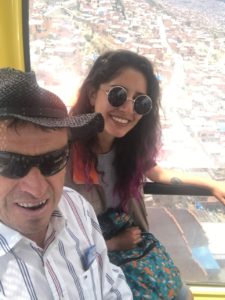 paid. Whilst looking around the city centre, I was confronted by tour guides who offered a tour to me for 50 bolivianos. 3 hour later, I was the biggest fan of the Bolivian cable ways and had a new friend, a very charming communications student.
paid. Whilst looking around the city centre, I was confronted by tour guides who offered a tour to me for 50 bolivianos. 3 hour later, I was the biggest fan of the Bolivian cable ways and had a new friend, a very charming communications student.
El Alto is the biggest market in South America, situated at 4000 meters above sea level. Here, you can buy absolutely anything and everything: dried lama foetus! There is 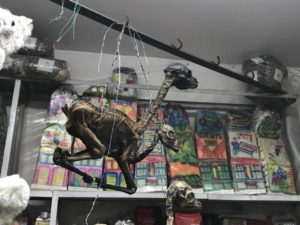 even a street with Brujas (witches) that you can book a ceremony with. For example, you can book for the bettering of someones soul or even install curses. I did not do either but I am still here for two days…
even a street with Brujas (witches) that you can book a ceremony with. For example, you can book for the bettering of someones soul or even install curses. I did not do either but I am still here for two days…
The French friends I made here were so impressed with the bicycle tour they did down the Carretera de la Muert. I booked this one to try it out, it’s time for Emmazwo to rest.
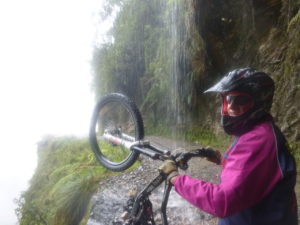
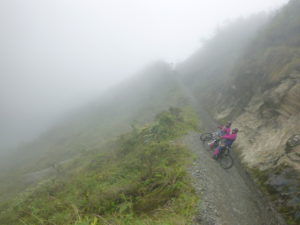
The tour is actually called Carretera del la Yungas and goes from 4400 meters to 1250 and is about 50km long. The fist 20km are in tar and then on a dirt road. The tour guide took lots of photos are let us stop a lot to look at the gorges. The exact track has been closed since 2006, it’s something I’d never want to actually drive a car on.
Throughout Europe, there’s lots of resting places for truck drivers so that they can have their breaks when driving long distances. They do not have that here, so the drivers are forced to drive much longer, staying awake on only coke and Bolivian whiskey. This obviously leads to unsafe driving situations, in the last week there have been 6 deaths.
I’m quite happy to be leaving Moloch La Paz, the little air up here is pretty much completely polluted.
Bolivia seems to be the worst country to be driving through, Emmazwo has suffered too much. I’ve been at around 3300-5000 meters above sea level for 4 weeks now. The human body gets used to it after a while, but every now and again it takes a bit of laboured breathing.
I read a guide for people travelling the mountains and it states that you should always descend a but more to lower heights when wanting to sleep.
If I ever return to Bolivia, I’ll do a lot more tours but definitely organise a bit better.
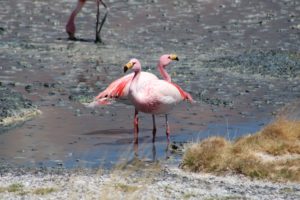
Bolivia is a very poor country, a super cheap place for us tourists. Ever since 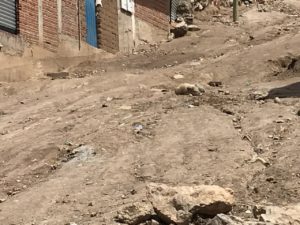 Evo Morales came into power, things have gotten better. The streets are much better and there is an Austrian cable way company operating a bit in La Paz with a whole net of cableways. Everyone seems to know Austria here.
Evo Morales came into power, things have gotten better. The streets are much better and there is an Austrian cable way company operating a bit in La Paz with a whole net of cableways. Everyone seems to know Austria here.
Evo Morales is going is in his third term in power (technically only two are allowed) and still wants to be voted for a fourth one. His posters are everywhere promoting him, surely there are other Bolivian politicians!
Communicating with the 60% local people is difficult, the communication with the 265 of Mestizo is much better. The 14% of white people are hiding in safe living estates and elite clubs
I golfed at the La Paz Golf club quite a bit. Quite an elitist club- the highest golf place in the world.
Like they say, golf balls always keep flying, I hit one right into the wall of the driving range while my teacher was watching…
I’m going to end the Bolivia blog here, off I go to the Titicaca See which will eventually become its own city.




